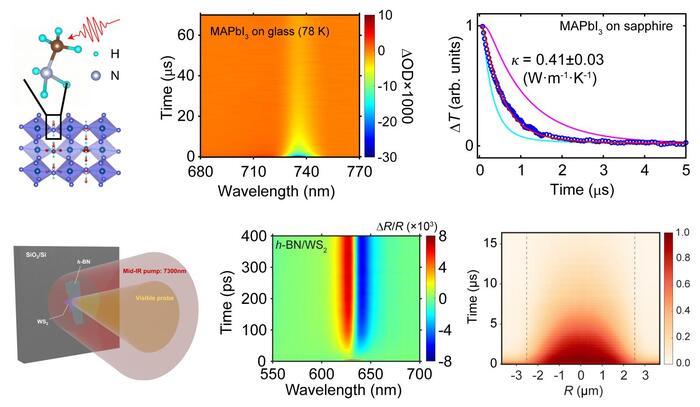Spatiotemporal measurements of energy transport in emerging materials
We develop and employ time-resolved optical technique called vibrational-pump visible-probe (VPVP) spectroscopy and VPVP imaging. In VPVP, a femtosecond mid-infrared (MIR) optical pump pulse directly excites vibrations of a material, after which the time-dependent optical transmittance or reflectance across the visible range is probed in the ns to ms time window. This versatile and transducer-free VPVP method, which we run both in spectroscopic and imaging configurations, is used by us for studying thermal transport properties of organic, polymeric, and hybrid organic-inorganic materials.

Relevant publications: J. Am. Chem. Soc. 2024, 146, 2187-2195; J. Phys. Chem. C 2023, 127, 3523-3531; Rev. Sci. Instrum. 2022, 93, 053003; Phys. Rev. X 2025, 15, 041054
Fundamental optical properties of hybrid and nanostructured materials
We harvest both solution-based synthesis and vapor-phase growth techniques to fabricate thin-film and nanostructured materials. Recently, we developed reflection-based techniques for measuring polarization-dependent linear optical properties of achiral and chiral two-dimensional perovskites, and elucidated the intrinsic chiroptical responses of these materials.

Relevant publications: Sci. Adv. 2024, 10, eadk2778; Nat. Commun. 2024, 15, 2573; J. Am. Chem. Soc. 2025, 147, 3631-3640
Excited-state dynamics and optical manipulation of functional materials
We investigate the dynamic processes of fundamental excitations (e.g., electrons, lattice vibrations) in solid-state and solution-phase materials. For example, we resolve the temporal and spatial characteristics of phase transformations of soft-lattice materials in both thin-film and single-crystal forms. Our optical setups are flexible, integrated, and routinely modified to engage with different measurements.

Relevant publications: Nanoscale 2024, 16, 5169-5176; ACS Photonics 2024, 11, 4507-4514; Matter 2023, 6, 460-474; Phys. Rev. Lett. 2022, 129, 177401